Abstract
Anthropogenic global challenges and environmental pressures are increasingly significant. Developing pro-environmental behavior and geoethics is crucial for enhancing awareness, action capability, and respect for natural systems. UNESCO Global Geoparks (UGGps) play a vital role in conserving geological and biological diversity while aligning with the United Nations’ Sustainable Development Goals. This quasi-experimental study, conducted during the 4th Summer School of Environmental Education on Geotopes and Sustainability at the Sitia UGGp, uses a pre–post design and comprehensive questionnaire to explore changes in participants’ sense of place and geoethical awareness. Results indicate significant improvements in place attachment, place meaning, and geoethical awareness. These findings suggest that stronger emotional bonds and deeper personal meanings related to the Sitia UGGp correlate with increased geoethical awareness. This research highlights the role of psychological connections in influencing geoenvironmental ethics and underscores the importance of place-based emotional and cognitive bonds in fostering geoethical thinking. However, this study’s limited sample size and the specific geographic context of Sitia UGGp may limit the generalizability of the findings. Despite these limitations, this study provides insights into the interplay of emotions, meanings, and geoethics within the sustainability and resilience spectrum.
1. Introduction and Objectives of This Study
The environment is shaped by complex interactions of natural and anthropogenic factors affecting ecological balance, quality of life, public health, cultural traditions, and aesthetic values [1]. Currently, pressing environmental challenges [2,3,4,5], exacerbated by urbanization [6,7,8], compromise natural capital [9,10] and threaten natural, cultural [11,12], and geological heritage [13]. The United Nations’ Sustainable Development Goals [14] offer a strategic framework to address these issues. In the “Anthropocene Era” [15,16,17], adopting modern geoenvironmental strategies [18,19,20], grounded in geoethics [3,5,21,22], is crucial. Pro-environmental behavior, aimed at enhancing environmental quality and sustainability [23,24,25,26,27,28,29,30], is essential to tackling these challenges.
UNESCO Global Geoparks (UGGps) are instrumental in conserving and promoting regions with significant geodiversity, biodiversity, geotourism, geoconservation, protection, education, sustainability, and resilience [31,32,33,34,35]. These UGGps foster a sense of belonging and responsibility [36], encouraging local communities to re-evaluate their heritage and rejuvenate areas through tourism, education, and eco-friendly activities [37]. Presently, there are 213 UGGps across 48 countries, with Greece hosting 9 [38]. The Sitia UGGp, established in 2015, is located on the easternmost edge of Crete, covering an area of 713.5 km2 and featuring geology of international significance [39].
Environmental education has aimed for over six decades to cultivate environmentally aware citizens capable of addressing environmental complexities [4,40,41,42]. Contemporary approaches focus on achieving short-, intermediate-, and long-term goals [43]. Specifically, geoeducation [44] involves integrating natural and cultural features with geology in both formal and informal settings [45]. This approach aims to raise awareness and foster participation in geoconservation efforts [46,47,48,49,50,51]. Place-based education [52,53,54,55], within the contemporary educational movement [56,57], emphasizes the importance of local geoenvironments in a globalized world [52,54], countering the alienation of humans from nature [58,59,60] and the focus on high-level academic knowledge [61].
In the geoenvironmental education literature, the sense of place is a pivotal concept [4,42,62], intersecting with geoethics [51,63]. Sense of place encompasses both the inherent characteristics of a place and the complex connections people have with it [64,65,66]. It explores the human connection to specific locations, influenced by physical, psychological, emotional, and experiential factors [67,68,69], combining biophysical and cultural elements [70]. It aims to understand how individuals form relationships with places and the factors contributing to this connection [69,71,72,73,74,75,76]. Key components include place attachment, the strength of emotional bonds to a place, and place meaning, the reasons behind these bonds [67,73,74,77]. Sense of place is a predictor of pro-environmental behavior [53,71,73,74,78,79,80,81,82], underscoring its potential impact.
Geoethics is an interdisciplinary field examining the interaction between human activities and the natural environment, especially within geosciences [3,5,21,22,83]. It addresses the ethical, social, and cultural implications of geoscientific knowledge and practices, aiming to raise awareness of Earth’s resources, geoenvironmental problems [21], sustainability, environmental responsibility, and social justice [84]. Geoethics seeks to establish shared values [85] promoting responsibility toward socio-ecological systems, aligning with natural environment preservation and community well-being [5]. It combines cognitive and emotional aspects essential for responsible human practices [22].
In light of growing global interest in geoenvironmental education, geoheritage, geoconservation, and geoethics [20,21,22,48,49,51,86,87,88], this study contributes to the literature on these domains with a novel approach. Building on the extensive review of Koupatsiaris and Drinia [63] on geoethics and geoenvironmental education interrelations, this study empirically explores the linkage between sense of place and geoethical awareness. This approach aims to shed new light on these interconnected fields.
This study aims to address the following research questions:
- Research question 1. Are the instruments used to assess place attachment, place meaning, and geoethical awareness valid and reliable?
- Research question 2. What changes occur in participants’ sense of place (including place attachment and place meaning) and geoethical awareness before and after participation in the summer school?
- Research question 3. Which demographic characteristics significantly impact participants’ sense of place and geoethical awareness?
- Research question 4. Is there a relationship between place attachment, place meaning, and geoethical awareness among the summer school participants?
2. Materials and Methods
2.1. Research Design
This study was conducted during the 4th Summer School of Environmental Education on Geotopes and Sustainability at the Sitia UGGp from 29 June to 4 July 2024. The summer school, titled “Georoutes in the Footsteps of the Sitia Deinotherium”, focused on the theme “Peace, Justice, and Strong Institutions: Promoting Peaceful Societies for Sustainable Development with Justice through Effective, Responsible, and Participatory Institutions—The Case of the Sitia Geopark”, aligning with the 16th Sustainable Development Goal. The event was coordinated by the Education Center for the Environment and the Sustainability of Ierapetra-Neapoli of the prefecture of Lasithi, Crete, in collaboration with the Sitia UGGp, and Education Centers for the Environment and the Sustainability of Archanes-Rouva-Gouves, Anogeia, Vamos, and the 2nd Laboratory Center of Natural Sciences of Crete. Activities were held in Karydi Sitia and the surrounding areas of the Sitia UGGp.
This research employed a quasi-experimental design with a single experimental group, using a pre–post technique [89,90]. A printed questionnaire, accompanied by an explanatory letter, was distributed at the beginning and end of the summer school. Four educators (a kindergarten teacher, a primary school teacher, a middle school French teacher, and a high school philologist) tested the questionnaire, before distribution, providing valuable feedback and minor corrections.
2.2. Participants
This study used a non-probability sampling method, specifically convenience sampling, due to the accessibility and willingness of the participants [89]. Although this approach has limitations regarding generalizability, it allowed us to address specific research questions [89,90]. The summer school program involved 50 educators from across Greece.
2.3. Data Collection
A total of 41 questionnaires were collected at the beginning of the summer school, and 36 were retrieved at the end. Ultimately, 33 matched pre–post questionnaires were included in the analysis. Data were coded and entered into Microsoft Excel for accuracy and reliability checks.
2.4. Questionnaire Instruments
The survey employed a comprehensive questionnaire divided into four sections: Section A (place attachment)—12 items, Section B (place meaning)—28 items, Section C (geoethicalawareness)—32 items, and Section D (demographic data—general information)—15 items (Supplementary Materials). The questionnaire was designed to ensure functionality, ease of completion, clarity, and participant friendliness [89].
Several quantitative, qualitative, and mixed-methods surveys were considered to assess the sense of place (place attachment and place meaning) [70,71,73,74,76,77,78,80,91,92,93,94,95,96,97,98,99,100,101,102,103,104]. The place attachment scale was adapted from Williams and Vaske [95] and also used by Semken et al. [67]. Williams and Vaske [95] reported reliability coefficients ranging from α = 0.84 to α = 0.94 for place identity and α = 0.81 to α = 0.94 for place dependence. The instrument consists of 12 items, with odd-numbered items measuring place identity, even-numbered items measuring place dependence, and the final item reverse-scored. It uses a 5-point Likert scale, where 1 corresponds to “Strongly disagree”, 2 to “Disagree”, 3 to “Neither disagree nor agree”, 4 to “Agree”, and 5 to “Strongly agree”. This 12-item Likert scale instrument ranges from 12 to 60, with scoresabove 36 indicating affirmative place attachment.
To evaluate place meaning among summer school participants, we adapted a scale originally developed by Young [92], which is based on the idea that “tourist places are socially constructed and negotiated phenomena” (p. 373). This scale captures the meanings of places as produced by the tourism industry and consumed by tourists, paralleling, in our opinion, the relationship between trainer and trainee. The original scale comprised 30 place-meaning items. Semken et al. [67] also used this scale, noting that although Young did not discuss the validity or reliability of the scale, “the items used are generic enough to be applicable to other parklands or wild places elsewhere” [67], and that “the scale is relevant to place-based educational contexts” [77]. We modified the scale to 28 items by removing “tropical” and “exotic” and changing “important for Aboriginal culture” to “important place for local culture” and “comfortable” to “tourism place”. This instrument uses a 5-point Likert scale, with 1 meaning “Does not fit at all”, 2 “Fits to some extent”, 3 “Neither fits nor does not fit”, 4 “Fits sufficiently well”, and 5 “Fits perfectly”. Items such as “overdeveloped”, “threatened”, “crowded”, and “dangerous” were reverse-scored to reflect place degradation. The total scale score ranges from 28 to 140, with scores of 84 and above indicating a high and robust place meaning.
To investigate geoethical awareness, we developed a new scale, as, to our knowledge, there has yet to be an established one in the literature. This scale is based on the rich theoretical framework of the geoethics literature [3,5,21,22,83,84,85,105,106,107]. According to Peppoloniand Di Capua [5], geoethical values encompass geoheritage, geoconservation, sustainability, adaptability, risk prevention, and geoenvironmental education. The primary goal of geoethics is to identify common values that underpin strategies and operational processes, ensuring respect for the natural environment, soil, and the health and safety of human communities [5,21]. To assess geoethical awareness among participants, we developed a series of geoethical questions reflecting these core values. Items 1–2 evaluate geoheritage; items 3–4 focus on geoconservation; items 5–6 examine geotourism; items 7–8 address geodiversity; items 9–10 pertain to biodiversity; items 11–12 consider geosources; items 13–14 discuss water management; items 15–16 relate to climate crisis issues; items 17–18 involve risk prevention; items 19–20 explore adaptation to changes; items 21–22 assess sustainability; items 23–24 reflect on resilience; items 25–26 cover community engagement; items 27–28 focus on environmental advocacy; items 29–30 evaluate the value of concrete ecological feelings; and items 31–32 consider geoenvironmental education potential. The instrument uses a Likert scale where 1 corresponds to “Strongly disagree”, 2 to “Disagree”, 3 to “Neither disagree nor agree”, 4 to “Agree”, and 5 to “Strongly agree”. The scale score ranges from a minimum of 32 to a maximum of 160, with a score of 96 indicating neutral geoethical awareness.
2.5. Ethical Consideration
Ethical standards were strictly adhered to throughout the research process, including obtaining informed consent, ensuring anonymity, protecting personal data, allowing participants to withdraw at any time, and ensuring their safety [89,90]. Permission for the survey was obtained from the summer school’s organizing committee.
2.6. Data Analysis
Data were analyzed using IBM SPSS Statistics software, version 29. Descriptive and inferential statistics were employed, with results presented through frequencies, percentages, tables, and charts. Normality tests (Kolmogorov–Smirnov and Shapiro–Wilk) indicated a non-normal distribution (p > 0.05). Non-parametric tests (Spearman’s rho, Mann–Whitney U, Kruskal–Wallis H, and Wilcoxon signed-rank) were used for correlation analyses. Multiple linear regression analysis was also conducted to understand the impact of independent variables of place attachment and place meaning on the dependent variable of geoethical awareness.
3. Results
3.1. Internal Consistency and Reliability for Three Scales Pre- and Post-Summer School
The internal consistency of the questionnaire’s three thematic sections (Section A: place attachment, Section B: place meaning, andSection C: geoethicalawareness) was assessed using Cronbach’s Alpha (Table 1). The reliability coefficients for these sections were exceptionally high, ranging from α = 0.917 to α = 0.955 both before and after the summer school at Sitia UGGp. Overall, the Cronbach’s Alpha coefficient across all three thematic sections was 0.967, indicating an outstanding level of internal consistency.

Table 1.
Internal consistency/reliability for the three scales pre- and post-summer school.
3.2. Descriptive Statistic
Among the survey participants, 12 (36.4%) were male and 21 (63.6%) were female, allowing for a comprehensive understanding of the summer school program’s impact on both genders.
Age distribution was as follows: 3 participants (9.1%) were aged 25 to 34, 9 participants (27.3%) were aged 35–44, 11 participants (33.3%) were aged 45–54, and 10 participants (30.3%) were aged 55 and above. The diverse age distribution provided a range of perspectives and experiences that could influence the research findings.
Regarding educational qualifications, 22 participants (66.7%) held a postgraduate degree, 8 participants (24.2%) had an undergraduate degree, and 3 participants (9.1%) possessed a Ph.D. The high academic background of participants could influence their understanding and engagement with the summer school program.
In terms of employment, 2 participants (6.1%) worked in kindergarten, 10 participants (30.3%) worked in primary school, 11 participants (33.3%) worked in middle school, 7 participants (21.2%) worked in high school, and 2 participants (6.1%) worked in other types of educational institutions.
Residentially, 7 participants (21.2%) lived in rural areas, 10 participants (30.3%) in semi-urban areas, and 16 participants (48.5%) in urban areas.
The demographic characteristics and general information of the participants shown in Table 2 provided a comprehensive understanding of the sample, facilitating the interpretation of the summer school program’s impact.

Table 2.
Demographic characteristics and general information of participants.
3.3. Place Attachment Analysis
In analyzing the “Place Attachment” thematic section of the questionnaire, we observed notable changes in participants’ responses before and after attending the summer school (Table 3).

Table 3.
Distribution of mean value, standard deviation, and total score for place attachment.
The subscale of place identity (items A1, A3, A5, A7, A9, and A11), which includes items measuring how participants perceive their emotional connection and identity with Sitia UGGp, showed significant variations in responses. Before the summer school, items related to place identity, such as item A3 (“Sitia Geopark is very special to me”), received a mean rating of 3.79 (S.D. = 0.178), indicating a relatively strong sense of attachment. However, item A7 (“I am very attached to Sitia Geopark”) had a lower mean rating of 3.36 (S.D. = 0.203), reflecting a more neutral stance.
After the summer school, participants’ responses showed a marked shift. Item A3’s mean rating increased to 4.33 (S.D. = 0.142), indicating a stronger agreement that Sitia UGGp is special to them. Similarly, item A5 (“I identify strongly with Sitia Geopark”) improved to a mean rating of 3.88 (S.D. = 0.161), demonstrating enhanced identification with the Sitia UGGp.
For place dependence (items A2, A4, A6, A8, A10, and A12), which measures the perceived uniqueness and importance of Sitia UGGp for specific activities, the responses also shifted significantly. Before the summer school, item A4 (“No other place can be compared to Sitia Geopark”) had the lowest mean rating of 2.58 (S.D. = 0.123), suggesting a lower perceived uniqueness of the Sitia UGGp. Item A2 (“Sitia Geopark is the best place for what I like to do”) had a higher mean rating of 3.39 (S.D. = 0.157).
Postsummer school, there was an increase in the mean rating for item A4, rising to 3.24 (S.D. = 0.163), indicating a greater sense of uniqueness. Item A2’s mean rating also increased to 3.79 (S.D. = 0.167), reflecting a stronger perception that Sitia UGGp is ideal for their activities.
Overall, the measure of place attachment, which combines both place identity and place dependence, showed a significant increase. The average score for place attachment rose from M = 3.30 (S.D. = 0.130) before the summer school to M = 3.80 (S.D. = 0.118) after the event. This substantial shift indicates a notable strengthening of participants’ emotional connections with Sitia UGGp.
The total score for place attachment also increased from 1286 units before the summer school to 1478 units after its conclusion.
In summary, the data clearly demonstrated that participation in the summer school positively influenced participants’ place attachment, reflecting the intended learning outcome of enhancing emotional connections in the context of geoenvironmental education, deepening participants’ bonds with Sitia UGGp.
3.4. Place Meaning Analysis
The analysis of the “Place Meaning” thematic section revealed significant shifts in participants’ perceptions of Sitia UGGp both before and after their attendance at the summer school (Table 4).

Table 4.
Distribution of mean value, standard deviation, and total score for place meaning.
Before the summer school, participants had a diverse range of views about Sitia UGGp. The highest mean ratings were observed for items related to the Sitia UGGp’s importance and authenticity. For example, items B7 (“Sitia Geopark is an important place to preserve”) and B8 (“Sitia Geopark is an authentic place”) both received high mean ratings of 4.55 (S.D. = 0.116 and S.D. = 0.107, respectively), indicating strong agreement with these perceptions. Participants also strongly agreed that Sitia UGGp was “peaceful” (item B22, mean = 4.52, S.D. = 0.088), “ecologically important” (item B15, mean = 4.42, S.D. = 0.151), “beautiful” (item B4, mean = 4.30, S.D. = 0.141), and “interesting” (item B20, mean = 4.30, S.D. = 0.111).
Conversely, there was little agreement with items suggesting negative attributes, such as the park being “overdeveloped” (item B12, mean = 1.64, S.D. = 0.143) or “crowded” (item B18, mean = 1.70, S.D. = 0.141). The perceptions of the Sitia UGGp as “spiritually significant” (item B23, mean = 2.79, S.D. = 0.188) or primarily for “fun” (item B16, mean = 2.85, S.D. = 0.209) were also relatively low.
After the summer school, participants’ perceptions of Sitia UGGp showed a notable shift. The perception of the Sitia UGGp as “overdeveloped” (item B12) slightly increased to a mean rating of 1.73 (S.D. = 0.152), but this was still low. On the other hand, perceptions of the Sitia UGGp as an “important place to preserve” (item B7) improved, with the mean rating rising to 4.73 (S.D. = 0.090). The Sitia UGGp was increasingly viewed as “authentic” (item B8, mean = 4.70, S.D. = 0.111), “relaxing” (item B10, mean = 4.70, S.D. = 0.081), “unique” (item B6, mean = 4.64, S.D. = 0.105), “culturally important” (item B11, mean = 4.64, S.D. = 0.105), “tranquil” (item B22, mean = 4.64, S.D. = 0.085), and “adventurous” (item B27, mean = 4.61, S.D. = 0.144). These changes indicate an enhancement in the symbolic meanings associated with the Sitia UGGp.
Participants continued to view Sitia UGGp as neither “crowded” (item B18, mean = 1.82, S.D. = 0.177) nor “dangerous” (item B19, mean = 1.94, S.D. = 0.184). Perceptions of the Sitia UGGp as primarily for “fun” (item B16, mean = 3.15, S.D. = 0.243) or “spiritually significant” (item B23, mean = 3.15, S.D. = 0.247) remained low.
Overall, the comprehensive measure of place meaning increased from a mean of 3.71 (S.D. = 0.089) before the summer school to a mean of 4.05 (S.D. = 0.085) after the event. This increase reflects a more substantial alignment with the idea that the Sitia UGGp“fits perfectly” with the positive attributes assessed.
The total score for place meaning also rose from 3639 units before the summer school to 3900 units after its completion.
In summary, the data indicate that participation in the summer school significantly enhanced participants’ perceptions of the symbolic meanings of Sitia UGGp as an intended learning outcome of geoenvironmental education, demonstrating a successful reinforcement of the Sitia UGGp’s cultural, ecological, and aesthetic value.
3.5. Geoethical Awareness Analysis
The thematic section on “Geoethical Awareness” examines the shifts in participants’ perceptions regarding geoethical issues before and after attending the summer school (Table 5).

Table 5.
Distribution of mean value, standard deviation, and total score for geoethical awareness.
The initial ratings indicated a strong foundation of understanding among participants, with average ratings ranging from “agree” to “strongly agree”. For instance, item C10 (“Biodiversity and geodiversity conservation in Sitia Geopark should be managed in a complementary manner”) had a mean of 3.88 (S.D. = 0.167). This item explicitly measures the participants’ understanding of the interdependence between biodiversity and geodiversity in the context of conservation. In contrast, item C21 (“All activities within Sitia Geopark should be guided by principles of sustainability to ensure long-term conservation”) had a mean of 4.55 (S.D. = 0.107), demonstrating a high level of agreement. This item focuses on the participants’ perception of the importance of sustainability in long-term conservation efforts. Notably, all item averages were above “agree”, with an overall average value above 4.00, reflecting a growing confidence in their understanding of geoethical issues.
Following the summer school, participants’ average ratings also significantly increased, ranging from “agree” to “strongly agree”. For example, item C10’s mean increased to 4.15 (S.D. = 0.175), indicating a more robust agreement that biodiversity and geodiversity conservation in Sitia UGGpshould be managed in a complementarymanner. Similarly, item C9 (“The protection of biodiversity within Sitia Geopark is as important as preserving geological features”) had a mean of 4.73 (S.D. = 0.079), demonstrating a high level of agreement. These significant increases in ratings suggest a positive impact of the summer school on participants’ understanding and appreciation of geoethical issues within Sitia UGGp.
Regarding geoheritage value, before the summer school, participants mostly agreed with item C2 (“Public awareness programs about geoheritage in Sitia Geopark significantly enhance community appreciation and protection efforts”, mean 4.42, S.D. = 0.098). After the summer school, participants highly rated both item C1 (“The preservation of geoheritage is essential for maintaining cultural and scientific values in Sitia Geopark”, mean 4.70, S.D. = 0.081) and item C2 (“Public awareness programs about geoheritage in Sitia Geopark significantly enhance community appreciation and protection efforts”, mean 4.70, S.D. = 0.081).
Focusing on geoconservation, before the summer school, participants prioritized item C4 (“Geoconservation in Sitia Geopark should be integrated into local development plans to ensure the sustainable use of geological resources”, mean 4.42, S.D. = 0.107). After the summer school, they rated item C3 (“Effective geoconservation strategies in Sitia Geopark are crucial for protecting geological features from degradation”, mean 4.64, S.D. = 0.085) higher.
Regarding geotourism, participants rated item C5 (“Geotourism activities within Sitia Geopark should prioritize sustainability”) highly before the summer school (mean = 4.45, S.D. = 0.098). This item remained highly rated after the summer school, with a slight increase (mean = 4.58, S.D. = 0.107).
At the start of the summer school, participants expressed their commitment to protecting the geodiversity of Sitia UGGp, considering it a significant contributor to ecological balance (item C7: “It is important to recognize and protect the geodiversity of Sitia Geopark as it contributes to ecological balance”, mean 4.48, S.D. = 0.098). This commitment, which remained steadfast after the summer school (mean 4.85, S.D. = 0.098), inspires all those involved in geoethical awareness and conservation efforts.
For biodiversity, participants rated item C9 (“The protection of biodiversity within Sitia Geopark is as important as preserving geological features”) highly before the summer school (mean = 4.18, S.D. = 0.187). This item maintained a high rating after the summer school, showing an increase (mean = 4.73, S.D. = 0.079).
Considering geosources, participants rated item C12 (“Regulations on the extraction of geosources in Sitia Geopark are necessary to prevent environmental degradation”, mean 4.12, S.D. = 0.183) highly before the summer school. This item remained highly rated after the summer school (mean 4.58, S.D. = 0.107).
Discussing water management, participants rated item C13 (“Sustainable water management practices are essential to maintain the ecological balance within Sitia Geopark”, mean 4.30, S.D. = 0.119) highly before the summer school, and this item remained highly rated after the summer school (mean 4.58, S.D. = 0.087).
Regarding the climate crisis, participants rated item C15 (“Sitia Geopark should implement strategies to mitigate the impacts of the climate crisis on its geological and biological resources”) highly before the summer school (mean = 4.33, S.D. = 0.128). This item remained highly rated after the summer school, with an increase (mean = 4.48, S.D. = 0.116).
For risk prevention, before the summer school, participants rated item C17highly(“Risk prevention measures are necessary to protect both geological and human resources within Sitia Geopark”, mean 4.39, S.D. = 0.115). After the summer school, they rated item C18 (“Adequate infrastructure and planning can significantly reduce the risks of natural disasters within Sitia Geopark,” mean 4.45, S.D. = 0.107) higher.
Exploring adaptation to changes, before attending the summer school, participants rated item C20 highly (“Continuous research and monitoring are vital for effective adaptation to changing conditions within Sitia Geopark”, mean 4.33, S.D. = 0.104), and this item remained highly rated after the summer school (mean 4.58, S.D. = 0.098).
Assessing sustainability, participants rated item C21 highly (“All activities within Sitia Geopark should be guided by principles of sustainability to ensure long-term conservation”) highly before attending the summer school (mean = 4.55, S.D. = 0.107). This item remained highly rated after the summer school, with an increase (mean = 4.70, S.D. = 0.081), indicating a strong commitment to sustainable practices and a heightened sense of environmental responsibility.
Reflecting on resilience, before attending the summer school, participants rated item C24 highly (“Community resilience in Sitia Geopark can be bolstered through education and involvement in conservation efforts”, mean 4.15, S.D. = 0.158), and this item remained highly rated after the summer school (mean 4.55, S.D. = 0.098).
Regarding community engagement, participants rated item C25highly(“Active community engagement is crucial for the success of conservation initiatives in Sitia Geopark”, mean 4.33, S.D. = 0.104) before attending summer school. This item remained highly rated after the summer school (mean 4.48, S.D. = 0.116), indicating a growing sense of community engagement and connection among the participants. This strong sense of community is a testament to the collective strength in conservation efforts.
Focusing on environmental advocacy, before attending the summer school, participants rated both item C27 (“Strong environmental advocacy initiatives are essential for raising awareness about conservation issues within Sitia Geopark”, mean 4.42, S.D. = 0.098) and item C28 highly (“Collaborating with environmental advocacy groups can amplify the impact of conservation efforts within Sitia Geopark”, mean 4.42, S.D. = 0.087). After the summer school, participants rated item C27 higher (mean 4.67, S.D. = 0.083).
Evaluating the value of concrete ecological feelings, before attending the summer school, participants rated item C30 highly (“Ecological experiences within Sitia Geopark should be designed to foster a sense of responsibility towards nature”, mean 4.45, S.D. = 0.116). This item remained highly rated after the summer school (mean 4.70, S.D. = 0.092).
Considering geoenvironmental education potential, before attending the summer school, participants rated item C32 highly (“Schools and educational institutions should be actively involved in geoenvironmental education initiatives within Sitia Geopark”, mean 4.52, S.D. = 0.104), and this item remained highly rated after the summer school (mean 4.61, S.D. = 0.097).
The comprehensive measurement of geoethical awareness showed a notable increase in average ratings from M = 4.30 (S.D. = 0.770) before the summer school to M = 4.53 (S.D. = 0.069) after. This shift reflects a move from “agree” to “strongly agree”, indicating an overall enhancement in participants’ geoethical awareness.
The total score across all items increased from 4536 units before the summer school to 4784 units after, highlighting the positive impact of the program on participants’ understanding and attitudes towards geoethical issues.
In summary, these findings highlight a marked effect on participants’ geoethical awareness, evidenced by significant increases in their agreement on various geoethical issues. The results underscore a strengthened commitment to integrated management, sustainability, preservation, community, and advocacy. Overall, the summer school effectively deepened participants’ comprehension and commitment to geoethical principles, contributing positively to the geoconservation efforts within Sitia UGGp.
3.6. Correlations of Questionnaire Scales
To understand the relationships between the three key scales of the questionnaire—place attachment (Scale A), place meaning (Scale B), and geoethicalawareness (Scale C)—Spearman’s rho correlation coefficients were calculated (Table 6). These correlations provide insight into how these dimensions interact and influence each other among participants.

Table 6.
Correlations of the three questionnaires’ scales.
There is a strong positive relationship between place attachment and place meaning (ρ = 0.734, p < 0.001, N = 33). This indicates that participants who feel a deep connection to Sitia UGGp also attribute significant importance to it. The high correlation suggests that a stronger attachment to the place enhances the perceived meaning and significance attributed to it.
A robust positive correlation is observed between place attachment and geoethical awareness (ρ = 0.664, p < 0.001, N = 33). Participants who exhibit a stronger attachment to Sitia UGGp tend to demonstrate higher geoethical awareness. This reflects that emotional and cognitive connection with the place are associated with a heightened understanding of geoethical issues.
There is a significant positive relationship between place meaning and geoethical awareness (ρ = 0.699, p < 0.001, N = 33). Participants who perceive greater importance in Sitia UGGp also show increased geoethical awareness. This relationship suggests that recognizing the value of the place is linked with a deeper understanding of and commitment to geoethical principles.
Place attachment and place meaning exhibited the highest correlation (ρ = 0.734), indicating a strong link between the emotional connection to the place and the significance attributed to it. Place meaning and geoethical awareness had a slightly lower correlation (ρ = 0.699), but still significant, highlighting that the perceived importance of the place is closely related to geoethical awareness. Place attachment and geoethical awareness showed a notable correlation (ρ = 0.664), emphasizing the association between a strong connection to the place and a higher level of geoethical understanding.
All correlations were positive and statistically significant, reflecting that increases in one scale generally accompany increases in the others.
These findings underscore the interconnected nature of place attachment, place meaning, and geoethical awareness. They highlight how the summer school may have effectively enhanced participants’ emotional and cognitive connections to Sitia UGGp, contributing to a more profound understanding and appreciation of geoethical issues.
3.7. Evaluation of Summer School Program Implementation Results
3.7.1. Place Attachment
To assess the effectiveness of the summer school program on participants’ connection to the Sitia UGGp, we conducted a non-parametric Wilcoxon signed-rank test. This test, appropriate for comparing two related samples, evaluated changes in the median levels of place attachment reported by participants before (APRE) and after (APOST) the summer school. Medians were calculated from the total sum of responses for each participant.
Encouragingly, 30 out of 33 participants reported a stronger connection to Sitia UGGp after the summer school, while only 2 reported a reduced connection. One participant’s perception remained unchanged (Table 7).

Table 7.
Ranks.
The Wilcoxon signed-rank test revealed a statistically significant difference between the pre- and post-program place attachment scores, with a Z-value of −4.785 and a p-value of less than 0.001 (Table 8). This result confirms that the observed changes are unlikely due to chance.

Table 8.
Test statistics a.
The data revealed a significant increase in the median place attachment score, rising from 41.00 before the summer school to 45.00 afterward (Table 9).

Table 9.
Descriptive statistics.
The total scores for place attachment for each participant illustrate a clear trend toward stronger connections with Sitia UGGp (Figure 1).
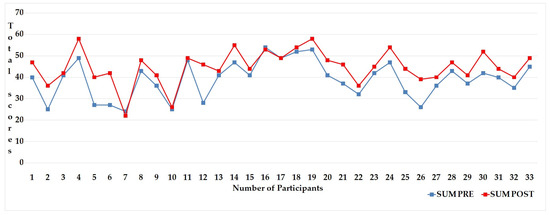
Figure 1.
Distribution of total place attachment scores among summer school participants.
The findings from the Wilcoxon signed-rank test and descriptive statistics indicate that the summer school substantially and positively affected participants’ attachment to Sitia UGGp. The program effectively enhanced the participants’ emotional and cognitive bonds with the Sitia UGGp, as evidenced by the increased median scores and the high number of participants reporting a strengthened connection. This underscores the success of the summer school in fostering a deeper appreciation and attachment to the Sitia UGGp among its participants.
3.7.2. Place Meaning
To evaluate the summer school’s influence on participants’ perceptions of the significance of the Sitia UGGp, a Wilcoxon signed-rank test was employed. This non-parametric test compared participants’ median responses on place meaning before (BPRE) and after (BPOST) the summer school, with medians calculated from the total responses of each participant.
Among the 33 participants, only 2 participants noted a reduced perception of the site’s importance, while a significant majority of 28 reported an enhanced perception of the Sitia UGGp’s importance following the summer school. Three participants maintained their initial views on the significance of the Sitia UGGp (Table 10).

Table 10.
Ranks.
The Wilcoxon signed-rank test revealed a statistically significant difference between the pre- and post-summer school assessments, with a Z-value of −4.282 and a p-value < 0.001 (Table 11). This significant result indicates that the observed changes are unlikely to be due to random chance.

Table 11.
Test statistics a.
The median score for place meaning increased from 110.00 before the summer school to 121.00 after the program (Table 12).

Table 12.
Descriptive statistics.
The upward shift in total scores for place meaning reflects a notable enhancement in participants’ valuation of the Sitia UGGp, attributable to the summer school experience (Figure 2).
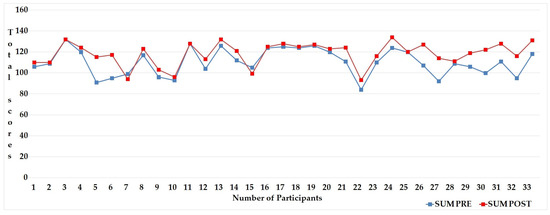
Figure 2.
Distribution of total place meaning scores among summer school participants.
The results demonstrate that the summer school had a significant positive impact on participants’ perceptions of the importance of the Sitia UGGp. The substantial increase in median place meaning scores highlights the program’s effectiveness in deepening participants’ appreciation and recognition of the Sitia UGGp’s cultural and natural value. This reinforces the role of educational initiatives in shaping and elevating the significance of heritage places.
3.7.3. Geoethical Awareness
To assess the impact of the summer school on participants’ geoethical awareness, a Wilcoxon signed-rank test was conducted. This non-parametric test compared the median scores for geoethical awareness before (CPRE) and after (CPOST) the summer school. Medians were calculated from the total responses of each participant.
A total of 26 out of 33 participants reported an increase in geoethical awareness following the summer school, while 4 participants experienced a decrease in geoethical awareness. Three participants showed no change in their levels of geoethical awareness (Table 13).

Table 13.
Ranks.
The Wilcoxon signed-rank test revealed a statistically significant difference between pre- and post-program measurements, with a Z-value of −4.085 and a p-value of less than 0.001 (Table 14). This result indicates that the observed changes in geoethical awareness are statistically significant and not due to random chance.

Table 14.
Test statistics a.
The median score for geoethical awareness increased from 139.00 before the summer school to 152.00 afterward (Table 15).

Table 15.
Descriptive statistics.
The notable increase in total scores for geoethical awareness indicates a positive shift in participants’ geoethical perceptions of the Sitia UGGp, reflecting the summer school’s effectiveness in enhancing their awareness (Figure 3).
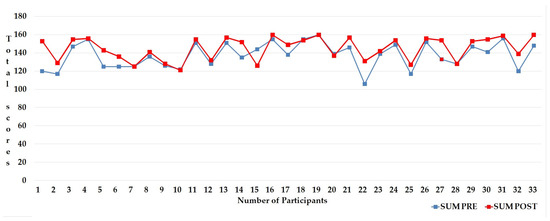
Figure 3.
Distribution of total geoethical awareness scores among summer school participants.
The results demonstrate that the summer school significantly improved participants’ geoethical awareness concerning the Sitia UGGp. The increase in median geoethical awareness scores underscores the program’s success in fostering a deeper understanding of ethical considerations related to the Sitia UGGp. These findings affirm the summer school’s role in enhancing participants’ geoethical perspectives and highlight its effectiveness in achieving its educational objectives.
3.8. Correlations with Demographic Characteristics and General Information
Our research further explored the correlations between the questionnaire scales (Section A: place attachment, Section B: place meaning, and Section C: geoethical awareness) and various demographic data and general information variables provided in Section D. This analysis aimed to understand how these variables might relate to participants’ responses on the three scales, focusing on years of teaching experience, involvement in Sitia UGGp-related workshops or training, development of environmental education programs, number of visits to the Sitia UGGp, and membership in environmental organizations or groups, as these factors were found to be statistically significant.
3.8.1. Correlations with Gender
We also examined whether gender had any impact on the responses to the three scales (place attachment, place meaning, and geoethical awareness) before (PRE) and after (POST) the summer school. Table 16 presents the results of our analysis, which used the Independent-Samples Mann–Whitney U Test to compare the distributions of the three scales across different gender categories.

Table 16.
Hypothesis test summary: correlation between gender and the three scales.
The results indicate that there were no statistically significant differences (p > 0.05) in the distributions of place attachment, place meaning, and geoethical awareness based on gender at both measurement points (PRE and POST). This suggests that gender did not influence the participants’ responses on these scales, thereby reinforcing the impartiality and fairness of the research findings.
Overall, these findings contribute to the robustness of the research by demonstrating that gender did not affect participants’ evaluations of place attachment, place meaning, or geoethical awareness in the context of the summer school.
3.8.2. Correlations with Years of Teaching Experience
To investigate the relationships between years of teaching experience and the three scales—place attachment (Section A), place meaning (Section B), and geoethical awareness (Section C)—we employed the non-parametric Kruskal–Wallis test. This test, suitable for comparing medians across three or more groups, was conducted both before and after the summer school (Table 17).

Table 17.
Hypothesis test summary: correlation between years of teaching experience and the three scales.
(a) Place attachment before the summer school (APRE): the Kruskal–Wallis test revealed a statistically significant difference in place attachment based on years of teaching experience, H(3) = 9.213 and p = 0.027 (Table 17). Participants with 21–30 years of teaching exhibited higher levels of place attachment (mean rank = 23.21) compared to those with 11–20 years of experience (mean rank = 10.77) (Figure 4).
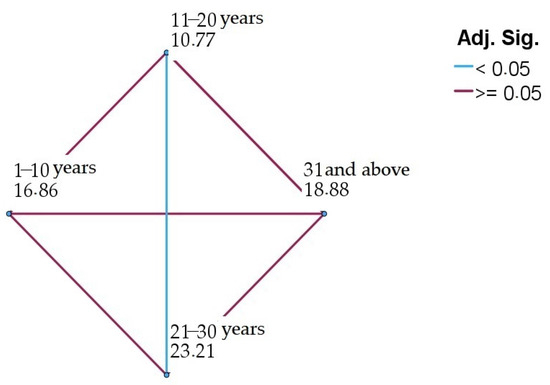
Figure 4.
Correlation of place attachment before the summer school with the years of teaching experience.
(b) Geoethical awareness before the summer school (CPRE): the Kruskal–Wallis test revealed a statistically significant difference in geoethical awareness was found based on teaching experience, H(3) = 10.624 and p = 0.014 (Table 17). Participants with 21–30 years of teaching experience demonstrated greater geoethical awareness (mean rank = 24.43) than those with 11–20 years of experience (mean rank = 10.92) (Figure 5).
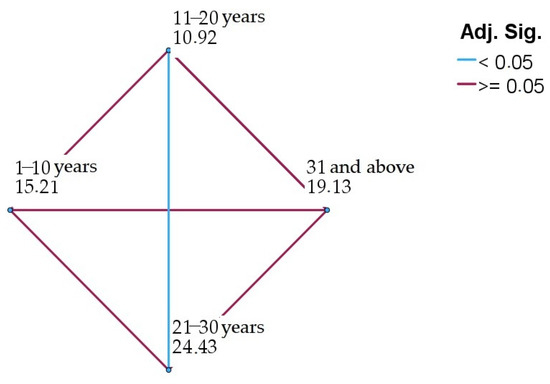
Figure 5.
Correlation of geoethical awareness before the summer school with the years of teaching experience.
(c) Place meaning after the summer school (BPOST): the Kruskal–Wallis test indicated a statistically significant difference in place meaning across teaching experience groups, H(3) = 8.950 and p = 0.030 (Table 17). Participants with 21–30 years of teaching experience had a higher degree of place meaning (mean rank = 24.14) after the summer school compared to those with 11–20 years of experience (mean rank = 12.04) (Figure 6).
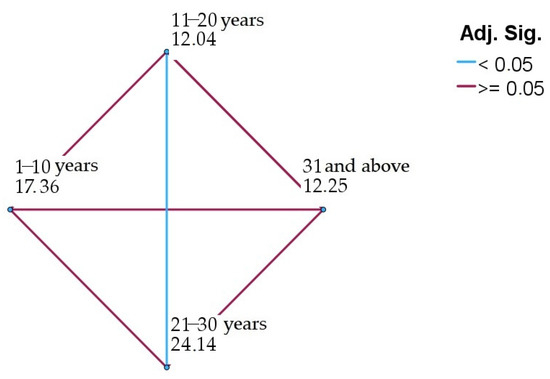
Figure 6.
Correlation of place meaning after the summer school with the years of teaching experience.
(d) Geoethical awareness after the summer school (CPOST): the Kruskal–Wallis test found a statistically significant difference in geoethical awareness post-summer school, H(3) = 10.276 and p = 0.016 (Table 17). Participants with 21–30 years of teaching experience exhibited higher geoethical awareness (mean rank = 23.29) compared to those with 11–20 years of experience (mean rank = 10.46) (Figure 7).
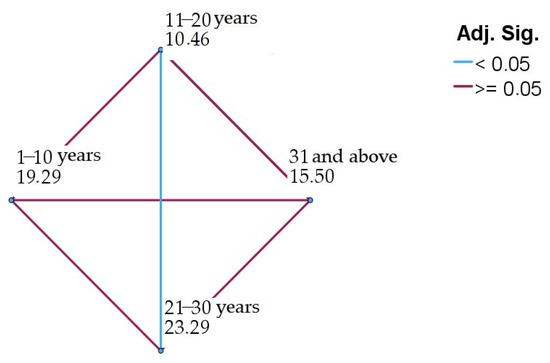
Figure 7.
Correlation of geoethical awareness after the summer school with the years of teaching experience.
The findings indicate that participants with more extensive teaching experience generally exhibited higher levels of place attachment, place meaning, and geoethical awareness both before and after the summer school. This pattern suggests that greater teaching experience is associated with a deeper connection to the place and enhanced geoethical understanding. These insights underscore the importance of considering teaching experience when evaluating the impact of educational programs on place-related perceptions and values.
3.8.3. Correlations with Involvement in Workshops or Training Sessions Related to the Sitia UGGp
To assess how involvement in workshops or training sessions related to the Sitia UGGp influences the three scales—place attachment (Section A), place meaning (Section B), and geoethical awareness (Section C)—we used the non-parametric Mann–Whitney U test (Table 18). This method is ideal for comparing two independent samples with non-normally distributed data.

Table 18.
Hypothesis test summary: correlation between involvement in workshops or training sessions related to the Sitia UGGp and the three scales.
(a) Place attachment before the summer school (APRE): the Mann–Whitney U test indicated a significant difference in place attachment based on participation in workshops or training sessions, U(16, 17) = 53.500 and p = 0.002 (Table 18). Participants who had attended such workshops or training sessions related to the Sitia UGGp reported higher levels of place attachment (mean rank = 22.16) compared to those who had not participated (mean rank = 12.15) (Figure 8).
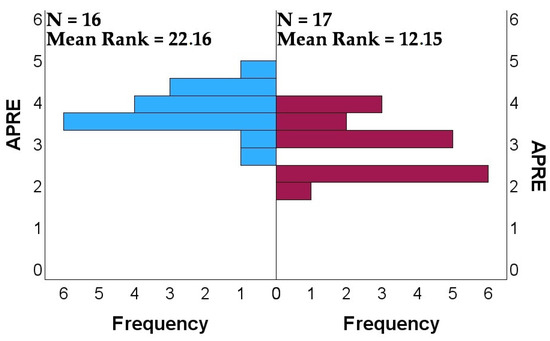
Figure 8.
Correlation of place attachment before the summer school with involvement in workshops or training sessions related to the Sitia UGGp.
(b) Place meaning before the summer school (BPRE): the Mann–Whitney U test found a significant difference in the perceived importance of the Sitia UGGp, U(16, 17) = 67.000 and p = 0.012 (Table 18). Participants who engaged in workshops or training sessions related to the Sitia UGGp had a higher appreciation for its significance (mean rank = 21.31) compared to those who did not attend (mean rank = 12.94) (Figure 9).
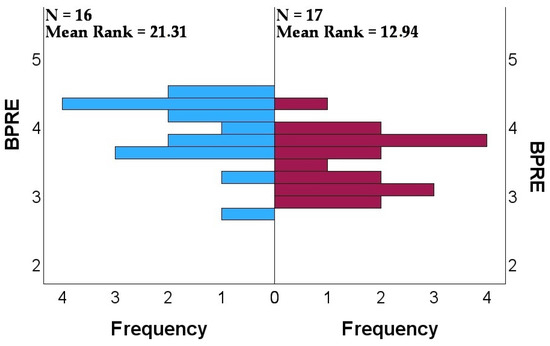
Figure 9.
Correlation of place meaning before the summer school with involvement in workshops or training sessions related to the Sitia UGGp.
(c) Place attachment after the summer school (APOST): the Mann–Whitney U test revealed a significant difference in the place attachment, U(16, 17) = 76.500 and p = 0.031 (Table 18). Participants with previous involvement in workshops or training sessions related to the Sitia UGGp demonstrated a stronger attachment (mean rank = 20.72) compared to those without prior engagement (mean rank = 13.50) (Figure 10).
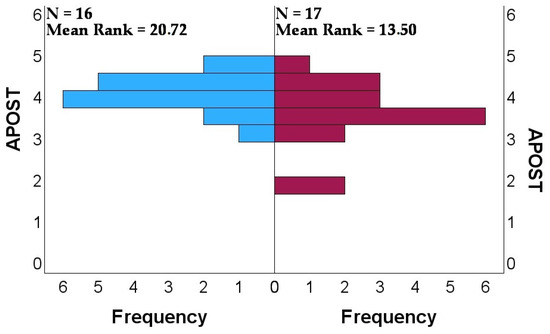
Figure 10.
Correlation of place attachment after the summer school with involvement in workshops or training sessions related to the Sitia UGGp.
The results underscore the positive impact of involvement in workshops or training sessions on participants’ connection to and appreciation for the Sitia UGGp. Participants who engaged in these preparatory activities exhibited higher levels of place attachment and place meaning both before and after the summer school, reinforcing the effectiveness of such preparatory engagements in enhancing participants’ overall experience and appreciation of the Sitia UGGp.
3.8.4. Correlations with the Development of Environmental Education Programs Related to the Sitia UGGp
To evaluate the influence of developing environmental education programs related to the Sitia UGGp on the three scales—place attachment (Section A), place meaning (Section B), and geoethical awareness (Section C)—we used the non-parametric Mann–Whitney U test. This test is particularly useful for comparing two independent samples, especially when data distributions are not normal (Table 19).

Table 19.
Hypothesis test summary: correlation between developing environmental education programs related to the Sitia UGGp and the three scales.
(a) Place attachment before the summer school (APRE): the Mann–Whitney U test revealed a significant difference in place attachment based on whether participants had developed environmental education programs related to the Sitia UGGp, U(8, 25) = 41.000 and p = 0.012 (Table 19). Participants who had engaged in such development reported higher levels of place attachment (mean rank = 24.38) compared to those who had not developed such programs (mean rank = 14.64) (Figure 11).
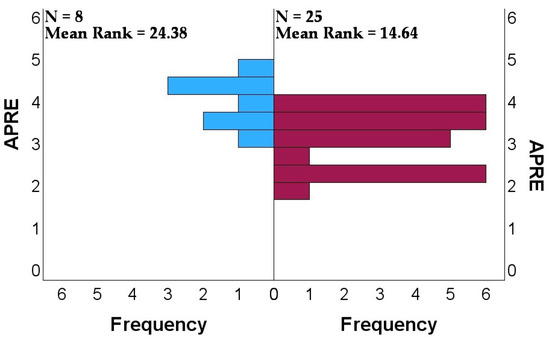
Figure 11.
Correlation of place attachment before the summer school with the development of environmental education programs related to the Sitia UGGp.
(b) Place meaning before the summer school (BPRE): the Mann–Whitney U test indicated a significant difference in the importance of the Sitia UGGp, U(8, 25) = 35.000 and p = 0.005 (Table 19). Participants involved in developing environmental education programs attributed greater importance to the Sitia UGGp (mean rank = 25.13) compared to those who had not been involved (mean rank = 14.40) (Figure 12).
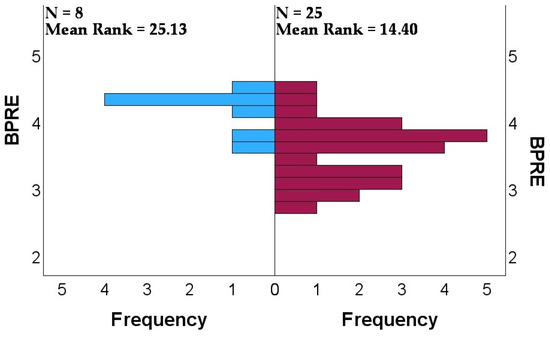
Figure 12.
Correlation of place meaning before the summer school with the development of environmental education programs related to the Sitia UGGp.
The findings indicate that involvement in developing environmental education programs related to the Sitia UGGp significantly enhances participants’ connection to and appreciation for the Sitia UGGp. Those who participated in or developed such programs exhibited stronger place attachment and placed greater importance on the Sitia UGGp before the summer school. These results suggest that engaging in or creating educational initiatives related to the Sitia UGGp can effectively deepen participants’ perceived connection and valuation of the Sitia UGGp. This insight provides valuable guidance for designing and implementing future environmental education programs.
3.8.5. Correlation with the Number of Visits to the Sitia UGGp
To explore the relationship between the number of visits to the Sitia UGGp and the three scales—place attachment (Section A), place meaning (Section B), and geoethical awareness (Section C)—we utilized the non-parametric Kruskal–Wallis H test. This test is appropriate for comparing medians across multiple groups. (Table 20).

Table 20.
Hypothesis test summary: correlation between the total number of visits to the Sitia UGGp and the three scales.
(a) Place attachment before the summer school (APRE): the Kruskal–Wallis H test indicated a statistically significant difference between the number of visits to the Sitia UGGp and place attachment, H(3) = 10.480 and p = 0.015 (Table 20). Participants who had visited the Sitia UGGp seven times or more exhibited higher place attachment (mean rank = 25.42) compared to those who had never visited (mean rank = 11.73) (Figure 13).
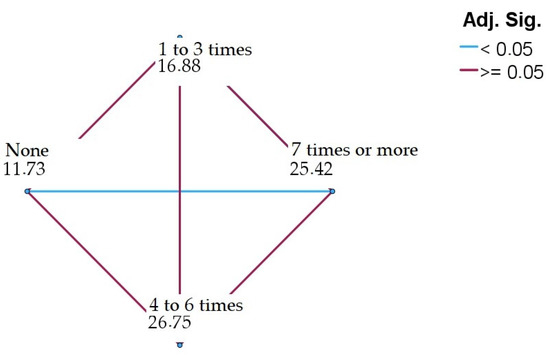
Figure 13.
Correlation of place attachment before the summer school with the number of visits to the Sitia UGGp.
The results suggest that the number of visits to the Sitia UGGp is positively associated with place attachment. Frequent visits to the Sitia UGGp strengthen participants’ connections to the place, enhancing their appreciation and sense of responsibility toward its preservation. This underscores the value of regular and immersive engagement with cultural and natural geotopes to foster deeper emotional bonds and a stronger commitment to their conservation.
3.8.6. Correlations with Membership in Environmental Organizations or Groups
To assess how membership in environmental organizations or groups affects participants’ scores on the three scales—place attachment (Section A), place meaning (Section B), and geoethical awareness (Section C)—we utilized the non-parametric Mann–Whitney U test. This approach is particularly useful for comparing differences between two independent groups (Table 21).

Table 21.
Hypothesis test summary: correlation between membership in environmental organizations or groups and the three scales.
(a) Place attachment before the summer school (BPRE): the Mann–Whitney U test indicated a significant difference in the perceived importance of the Sitia UGGp based on membership in environmental organizations or groups, U(10, 23) = 58.000 and p = 0.025 (Table 21). Participants who were members of such organizations or groups attributed a higher importance to the Sitia UGGp (mean rank = 22.70) compared to those who were not members (mean rank = 14.52) (Figure 14).
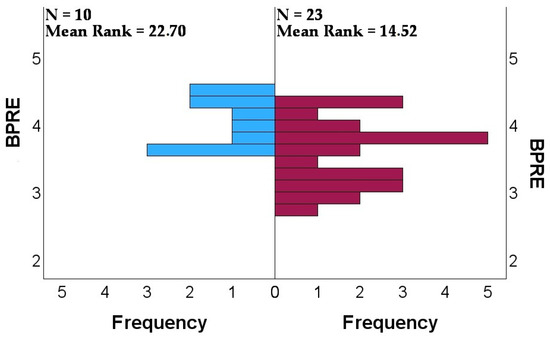
Figure 14.
Correlation of place meaning after the summer school with the membership in environmental organizations or groups.
This finding highlights that individuals who are members of environmental organizations or groups tend to place greater importance on the Sitia UGGp before attending the summer school. Membership in these organizations likely enhances participants’ awareness and valuation of environmental and cultural sites, suggesting that engagement in such groups fosters a more profound appreciation for these areas. These results suggest that environmental organizations play a crucial role in shaping and reinforcing perceptions of environmental significance, which may contribute to a greater sense of attachment and responsibility towards natural and cultural heritage.
3.9. Multiple Linear Regression Analysis with Geoethical Awareness as the Dependent Variable (Pre-Intervention)
To investigate the potential for creating a predictive model for geoethical awareness (dependent variable, CPRE) we performed a multiple linear regression analysis. The aim was to identify which variables could reliably predict geoethical awareness before the summer school intervention. This technique uses several explanatory variables to predict the outcome of a response variable. The model included the following independent variables: place attachment (APRE), place meaning (BPRE), gender, years of teaching experience, involvement in workshops or training sessions related to the Sitia UGGp, development of environmental education programs related to the Sitia UGGp, number of visits to the Sitia UGGp, and membership in environmental organizations or groups.
Following a stepwise procedure, it was determined that two variables—place attachment (APRE) and place meaning (BPRE)—significantly contributed to the model (Table 22).

Table 22.
Stepwise procedure: variables entered/removed a.
The final model, which included place attachment (APRE) and place meaning (BPRE), had an adjusted R2 of 0.583. This indicates that these two variables explain 58.3% of the variance in geoethical awareness (Table 23).

Table 23.
Model summary c.
Further model testing using the analysis of variance (ANOVA) methodrevealed statistically significant differences: place attachment [F(1,29) = 34.330, p < 0.001] and place meaning [F(2,28) = 21.990, p < 0.001] (Table 24). These results indicate that place attachment and place meaning were significant predictors of geoethical awareness, with place attachment showing a more substantial effect than place meaning.

Table 24.
ANOVA a method.
The final regression equation for geoethical awareness is Y = b0 + b1×1 + b2×2. Therefore, the equation is as follows: Geoethical Awareness = 2.128 + 0.281 × Place Attachment + 0.332 × Place Meaning, as shown in Table 25.

Table 25.
Coefficients a.
This equation suggests that a one-unit increase in place attachment, while keeping place meaning constant, is associated with a 0.281 unit increase in geoethical awareness. Similarly, a one-unit increase in place meaning, while maintaining place attachment constant, is related to a 0.332 unit increase in geoethical awareness. Place attachment significantly affects the prediction model, with a standardized coefficient B = 0.458. This means that for every one-unit increase in place attachment, the predicted value of geoethical awareness increases by 0.458 unit (Table 25).
As part of the multicollinearity check, we examined the tolerance index (Tolerance) and the variance inflation factor (VIF). The collinearity check confirmed the independence of the variables, with max VIF < 5 and Tolerance > 0.2 (Table 25), indicating no significant multicollinearity among predictors.
The Durbin–Watson test value of 1.928 < 2.000 indicated that the residuals are independent (Table 23). Upon completing the model, we verified that the residuals’ normal distribution was met (Figure 15 and Figure 16).
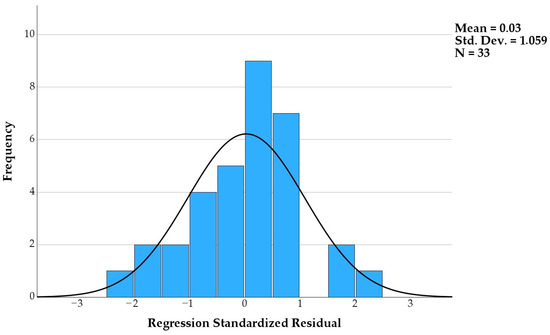
Figure 15.
Histogram of standardized residuals.
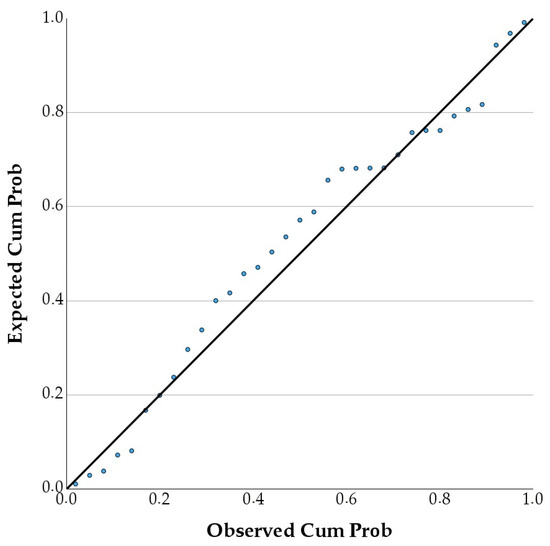
Figure 16.
Q-Q plot of standardized residuals.
In addition to these analyses, the homoscedasticity of residuals was assessed, indicating constant variance of residuals (Figure 17).
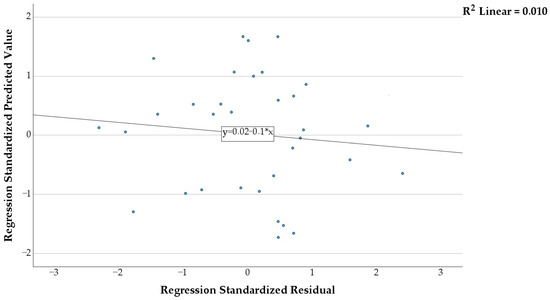
Figure 17.
Homoscedasticity test of residuals.
Spearman’s rho test was also conducted to examine the correlation among residuals (ρ = −0.128, p = 0.477, N =33), indicating no significant correlation (Table 26).

Table 26.
Correlations among the residuals.
In summary, the multiple linear regression analysis confirms that place attachment (APRE) and place meaning (BPRE) significantly predict geoethical awareness (CPRE) before the summer school concerning Sitia UGGp. Place attachment emerged as a stronger predictor. The model’s reliability was supported by satisfactory statistical assumptions, including multicollinearity, residual independence, and normality. This analysis underscores the importance of emotional and cognitive connections to places in fostering geoethical awareness, validating the relevance of place attachment and place meaning in understanding participants’ geoethical perspectives.
4. Discussion
4.1. A Concise Overview of Geoconservation, Geoenvironmental Education, and Geoethics in Fostering Human–Environmental Relationships
Within the geosciences realm, safeguarding biotic, abiotic, and cultural elements [108] is crucial for sustaining life [109], human, social, and natural capital [3], and sustainability and resilience. Geoconservation [46,47,48,49,51,110] encompasses geodiversity and biodiversity [111], highlighting biological, geological, and cultural heritage [47,112].
Geoenvironmental education [40,41,42,43,44] and geoethics [3,5,21,22,83,84,85] consider place central to human development [113], shaping our perception of the world [114]. Place embodies a fusion of representational, sociological, ideological, political, and ecological dimensions [115], conveying positive or negative sentiments in the relationship between humans and the environment [116].
Summer schools and other geoeducational programs, across formal, non-formal, and informal contexts, implement place-based education [53,54,55,60,61,62], reconnecting individuals to place and fostering a positive bond towards nature, the environment, the Earth, and humanity [55]. These programs address place, self, and the community [52,114,117], aiming to develop a strong sense of place and geoethical awareness.
Developing a strong sense of place [64,65,66,67,68,69,71,72,73,74,75,76], as a goal of geoenvironmental education, can lay the foundation for creating a responsible, cooperative, and safe world [118]. It enhances emotional connection and symbolic meanings of place [80], encourages engagement in place-protective behavior [71], and promotes green behaviors [119], spanning from local regions to entire UGGps.
Geoethics offers a new reading key for rethinking the Earth as a system of complex relationships, where humans are integral to natural interactions [5], advocating for sustainable geocentric human practices [22,120]. This perspective emphasizes coexisting with the environment [84], advancing practices that align with geoethics as public and global ethics [121].
4.2. Summary of Key Findings
This study on investigating sense of place and geoethics found that the scales used to assess sense of place—comprising place attachment and place meaningas well as geoethical awareness—exhibited high reliability both before and after the summer school at Sitia UGGp, with a notably high coefficient for all three scales (Table 1). While the place attachment and place meaning scales have been validated in previous surveys [67,77,92,95], it is particularly noteworthy that our newly developed geoethical awareness scale also demonstrated strong internal consistency, supporting its reliability and potential for broader application.
The evaluation of place attachment, which includes both place identity and dependence, showed a significant increase from before to after the summer school (Table 3), reflecting a strengthened emotional connection with Sitia UGGp. Concurrently, place meaning assessments also demonstrated a notable enhancement (Table 4), indicating the program’s success in enriching participants’ perceptions of the Sitia UGGp’s cultural, ecological, and aesthetic value. Additionally, geoethical awareness saw a substantial rise (Table 5), highlighting a marked improvement in participants’ understanding of geoethical issues and their commitment to integrated management, sustainability, and conservation. Overall, the summer school effectively deepened participants’ emotional bonds and geoethical principles, contributing positively to geoconservation efforts at Sitia UGGp.
The analysis revealed positive and statistically significant correlations among the three scales (Table 6). A strong positive correlation was observed between place attachment and place meaning, indicating that participants who felt a deep emotional connection to Sitia UGGp also attributed significant importance to it, suggesting that a stronger attachment enhances the perceived meaning and significance of the place. Additionally, a robust positive correlation was found between place attachment and geoethical awareness, showing that participants with a greater attachment to Sitia UGGp demonstrated higher levels of geoethical awareness, reflecting that both emotional and cognitive connections with the place are linked to a greater understanding of geoethical issues. Similarly, a significant positive relationship was identified between place meaning and geoethical awareness, with participants who recognized the greater importance of Sitia UGGp also exhibiting increased geoethical awareness, suggesting that valuing the place is associated with a deeper understanding of and commitment to geoethical principles. These findings highlight the interrelated nature of place attachment, place meaning, and geoethical awareness, indicating that the summer school effectively strengthened participants’ emotional and cognitive ties to Sitia UGGp, leading to a more profound understanding and appreciation of geoethical issues.
The evaluation of the summer school demonstrated a significant and positive impact on participants’ attachment to Sitia UGGp. The program notably enhanced both emotional and cognitive connections, as evidenced by increased median scores and a high number of participants reporting a strengthened bond (Table 7 and Table 8, Figure 1). Additionally, the summer school effectively improved participants’ perceptions of the Sitia UGGp’s importance, as reflected by a substantial rise in median place meaning scores, highlighting the program’s success in deepening participants’ appreciation of Sitia UGGp’s cultural and natural significance (Table 10 and Table 11, Figure 2). Furthermore, the program significantly boosted participants’ geoethical awareness, with increased median scores underscoring its effectiveness in promoting a more profound understanding of ethical issues related to Sitia UGGp (Table 13 and Table 14, Figure 3). These results confirm the summer school’s success in achieving its educational goals and enhancing participants’ connections to and perspectives on the Sitia UGGp.
The correlations with demographic characteristics revealed key factors influencing place attachment, place meaning, and geoethical awareness. Participants with more extensive teaching experience demonstrated higher levels of place attachment, place meaning, and geoethical awareness both before and after the summer school, suggesting that greater teaching experience enhances connections to the place and understanding of geoethical issues (Table 17). Additionally, involvement in workshops or training sessions positively impacted participants’ attachment to and appreciation for Sitia UGGp. Those engaged in these preparatory activities showed increased place attachment and place meaning, underscoring the value of such preparatory engagements (Table 18). Furthermore, participation in developing environmental education programs related to Sitia UGGp was associated with stronger place attachment and higher perceived importance of the site. This suggests that involvement in creating educational initiatives can deepen participants’ connection to and valuation of the Sitia UGGp, providing useful guidance for future program design (Table 19). The frequency of visits to Sitia UGGp was positively linked to place attachment, indicating that regular engagement fosters a stronger emotional bond and commitment to conservation (Table 20). Lastly, membership in environmental organizations was associated with greater perceived importance of Sitia UGGp. This highlights the role of such organizations in shaping and reinforcing environmental values, contributing to enhanced attachment and responsibility toward natural and cultural heritage (Table 21).
Lastly, the multiple linear regression analysis demonstrated that both place attachment and place meaning significantly predict geoethical awareness prior to the summer school at Sitia UGGp, with place attachment being the stronger predictor. The model met all statistical criteria, including multicollinearity, residual independence, and normality, ensuring its reliability (Table 23, Table 24 and Table 25). These results underscore the crucial role of emotional and cognitive connections with places in developing geoethical awareness, validating the significance of place attachment and place meaning in understanding geoethical viewpoints.
4.3. Research Gaps and Future Research Directions
Building on the findings, which provide valuable insights into the relationship between various factors and geoethical awareness, we identify several research gaps forming the basis for future exploration. The following future research directions are proposed to enhance the understanding and application of geoethical awareness and sense of place.
Since the study design primarily focused on pre- and post-intervention data, conducting longitudinal studies to track changes in geoethical awareness, place attachment, and place meaning over extended periods will help understand the sustainability and evolution of these concepts beyond the immediate post-summer school phase. This can provide insights into how these attitudes develop and persist over time.
Integrating theoretical frameworks and methodologies from psychology, sociology, education, and environmental science can provide a holistic understanding of the factors influencing geoethical awareness. Using interdisciplinary approaches can enhance the design and effectiveness of educational interventions. Additionally, incorporating qualitative methods such as interviews, focus groups, and ethnographic studies can offer deeper insights into participants’ personal experiences, motivations, and perceptions. These qualitative approaches can complement quantitative findings, uncovering nuanced aspects of geoethical awareness and sense of place.
As this study focused on the Sitia UGG, conducting comparative research involving multiple UGGps, protected areas, and environmental sites can help identify common factors and unique attributes that influence geoethical awareness. Such studies can reveal broader patterns and place-specific characteristics that contribute to place attachment and meaning. Furthermore, exploring how attitudinal changes in geoethical awareness translate into actual environmental behaviors is essential. Tracking participants’ engagement in conservation activities, policy advocacy, and sustainable practices can shed light on the practical impact of educational interventions on behavior.
Evaluating the content of geoenvironmental education programs to determine which specific themes and messages are most effective in fostering geoethical awareness can aid in designing more impactful curricula. Experimenting with innovative educational practices such as experiential learning, service learning, place-based education, and citizen science can further improve their effectiveness. Translating research findings into practical strategies and policies for educational institutions, local governments, and environmental organizations is crucial. These stakeholders can use insights to enhance geoethical awareness and promote sustainable practices.
Expanding on the direction of validating the proposed scale for measuring geoethical awareness can provide greater insights and stronger recommendations for future research. Large-scale research can ensure its reliability, validity, and generalizability. This scale could then be applied across various contexts, such as UGGps, protected areas, national parks, or other geoenvironmental sites of interest, contributing to a comprehensive understanding and promotion of geoethical awareness and sustainable behaviors.
By pursuing these research directions, scholars, academics, and stakeholders can build a more robust and comprehensive understanding of the factors influencing geoethical awareness, place attachment, and place meaning. This will contribute to more effective geoenvironmental education and geoconservation efforts, fostering sustainability, resilience, respect for geological, natural, and cultural heritage, geoethical thinking, and pro-environmental behavior in our challenging epoch.
4.4. Limitations of This Study
We acknowledge several limitations in our research. First, the relatively small sample size may limit the generalizability of our findings. Second, the absence of a control group makes it difficult to isolate the effects of the summer school from other influencing factors. Third, self-selection bias might be present, as individuals who chose to attend the summer school could already possess higher levels of geoethical awareness or sense of place. Fourth, the survey relies on self-reported measures, which are susceptible to biases such as social desirability, recall bias, and individual interpretation of survey items. Additionally, the constructs of place attachment, place meaning, and geoethical awareness may conceptually overlap, making it challenging to disentangle their unique contributions. Moreover, the survey assesses geoethical awareness, place attachment, and place meaning only before and shortly after the summer school, without evaluating the long-term impacts and sustainability of these changes. Lastly, this study’s focus on the Sitia UGGp may limit the applicability of our findings to other geographic regions or types of protected areas.
5. Conclusions
In the “Anthropocene Era”, humanity faces the complexities of a rapidly changing world. Addressing these pressing environmental challenges requires more than merely promoting environmental awareness and literacy. A contemporary approach emphasizes sustainable change, the cultivation of responsible citizens, intergenerational justice, diversity, quality of life, respect for natural dynamics, and action-oriented capabilities.
Geoconservation integrates geodiversity, biodiversity, and cultural aspects to instill fundamental principles and values in society. Geoethics offers a framework and methodologies for reshaping people’s perceptions and relationships with the Earth, prioritizing all forms of life, geosources, sustainability, and resilience, thereby strengthening the connection between people and places.
This study provides compelling evidence that place-based experiential learning and active engagement in geoenvironmental education are crucial for fostering enhanced geoethical awareness and a stronger sense of place. Incorporating these elements into educational frameworks can significantly improve the effectiveness of geoenvironmental education programs. By integrating these approaches, policymakers and educators can establish essential foundations for geoeducation that embraces geoethics.
Future research should investigate the longitudinal impacts of geoenvironmental education, explore diverse geographic contexts, and incorporate interdisciplinary approaches, including qualitative methods. Additionally, it should examine behavioral outcomes, policy implications, and practical applications. These efforts will enhance our understanding of the factors that contribute to geoethical awareness, strengthen the sense of place, and promote pro-environmental advocacy and stewardship.
Supplementary Materials
The following supporting information can be downloaded at: https://www.mdpi.com/article/10.3390/geosciences14100269/s1.
Author Contributions
Conceptualization, A.A.K. and H.D.; methodology, A.A.K.; investigation, A.A.K.; resources, A.A.K.; data curation, A.A.K.; writing—original draft preparation, A.A.K.; writing—review and editing, H.D.; supervision, H.D. All authors have read and agreed to the published version of the manuscript.
Funding
This research received no external funding.
Institutional Review Board Statement
Not applicable.
Informed Consent Statement
Not applicable.
Data Availability Statement
Data are contained within this article.
Acknowledgments
The authors gratefully thank the journal’s academic editor and the reviewers for thoroughly considering this paper. We also want to express our gratitude to the 4th Summer School of Environmental Education on Geotopes and Sustainability organizing committee at Sitia UNESCO Global Geopark and all the participants involved in our study.
Conflicts of Interest
The authors declare no conflicts of interest.
References
- Greek Legislation 1650/1986. For the Protection of the Environment. (F.E.K. A′160/10-16.10.1986). Available online: https://www.e-nomothesia.gr/kat-periballon/n-1650-1986.html (accessed on 24 July 2024). (In Greek).
- Scoullos, M.; Alambei, B.; Kouroutos, B.; Malotidi, M.; Mantzara, M.; Psallidas, B. (Eds.) Environmental Education and Education for Sustainable Development in Protected Areas: Educational Material; MIO-ECSDE: Athens, Greece, 2008; Available online: http://mio-ecsde.org/epeaek09/book/perivallontikiekpaidefsi.pdf (accessed on 24 July 2024). (In Greek)
- Peppoloni, S.; Di Capua, G. Geoethics and Geological Culture: Awareness, Responsibility and Challenges. Reflections from the Geoitalia Conference 2011. Ann. Geophys. 2012, 55, 335–341. [Google Scholar] [CrossRef]
- Krasny, M.E. Advancing Environmental Education Practice; Cornell University Press: New York, NY, USA, 2020; Available online: https://d119vjm4apzmdm.cloudfront.net/open-access/pdfs/9781501747083.pdf (accessed on 24 July 2024).
- Peppoloni, S.; Di Capua, G. Geoethics. Manifesto for an Ethics of Responsibility towards the Earth; Springer: Cham, Switzerland, 2022. [Google Scholar] [CrossRef]
- Fragkias, M.; Güneralp, B.; Seto, K.C.; Goodness, J. A Synthesis of Global Urbanization Projections. In Urbanization, Biodiversity and Ecosystem Services: Challenges and Opportunities; Elmqvist, T., Fragkias, M., Goodness, J., Güneralp, B., Marcotullio, P.J., McDonald, R.I., Parnell, S., Schewenius, M., Sendstad, M., Seto, K.C., et al., Eds.; Springer: Dordrecht, The Netherlands, 2013; Volume 21, pp. 409–435. [Google Scholar] [CrossRef]
- United Nations, Department of Economic and Social Affairs, Population Division. World Population Prospects 2019; Volume II: Demographic Profiles; ST/ESA/SER.A/427; United Nations: New York, NY, USA, 2019; Available online: https://population.un.org/wpp/Publications/Files/WPP2019_Volume-II-Demographic-Profiles.pdf (accessed on 24 July 2024).
- United Nations, Department of Economic and Social Affairs, Population Division. World Population Prospects 2022; Summary of Results; UN DESA/POP/2022/TR/NO. 3; United Nations: New York, NY, USA, 2022; Available online: https://www.un.org/development/desa/pd/sites/www.un.org.development.desa.pd/files/wpp2022_summary_of_results.pdf (accessed on 24 July 2024).
- World Forum on Natural Capital. What Is Natural Capital? Available online: https://naturalcapitalforum.com/about/ (accessed on 24 July 2024).
- Gray, M. The Confused Position of the Geosciences within the “Natural Capital” and “Ecosystem Services” Approaches. Ecosyst. Serv. 2018, 34, 106–112. [Google Scholar] [CrossRef]
- Kapsomenakis, J.; Douvis, C.; Poupkou, A.; Zerefos, S.; Solomos, S.; Stavraka, T.; Melis, N.S.; Kyriakidis, E.; Kremlis, G.; Zerefos, C. Climate Change Threats to Cultural and Natural Heritage UNESCO Sites in the Mediterranean. Environ. Dev. Sustain. 2023, 25, 14519–14544. [Google Scholar] [CrossRef]
- Falk, M.T.; Hagsten, E. A Threat to the Natural World Heritage Site Rarely Happens Alone. J. Environ. Manag. 2024, 360, 121113. [Google Scholar] [CrossRef]
- Fuertes-Gutiérrez, I.; García-Ortiz, E.; Fernández-Martínez, E. Anthropic Threats to Geological Heritage: Characterization and Management: A Case Study in the Dinosaur Tracksites of La Rioja (Spain). Geoheritage 2016, 8, 135–153. [Google Scholar] [CrossRef]
- United Nations. Transforming our World: The 2030 Agenda for Sustainable Development. 2015. Available online: https://sustainabledevelopment.un.org/content/documents/21252030%20Agenda%20for%20Sustainable%20Development%20web.pdf (accessed on 24 July 2024).
- Crutzen, P.; Stoermer, E. The “Anthropocene”. Glob. Chang. Newsl. 2000, 41, 17–18. Available online: http://www.igbp.net/download/18.316f18321323470177580001401/1376383088452/NL41.pdf (accessed on 24 July 2024).
- Castree, N. The Anthropocene: A Primer for Geographers. Geography 2015, 100, 66–75. [Google Scholar] [CrossRef]
- Zalasiewicz, J.; Waters, C.; Summerhayes, C.; Williams, M. The Anthropocene. Geol. Today 2018, 34, 177–181. [Google Scholar] [CrossRef]
- Sterling, S. Living in the Earth. Towards an Education for our Times. J. Educ. Sustain. Dev. 2010, 4, 213–218. [Google Scholar] [CrossRef]
- Gordon, J.E.; Barron, H.F.; Hansom, J.D.; Thomas, M.F. Engaging with Geodiversity—Why it Matters. Proc. Geol. Assoc. 2012, 123, 1–6. [Google Scholar] [CrossRef]
- Gray, M. Geodiversity, Geoheritage and Geoconservation for Society. Intern. J. Geoherit. Parks 2019, 7, 226–236. [Google Scholar] [CrossRef]
- Di Capua, G.; Peppoloni, S. Website of the International Association for Promoting Geoethics. Available online: https://www.geoethics.org/ (accessed on 24 July 2024).
- Bohle, M.; Marone, E. Geoethics, a Branding for Sustainable Practices. Sustainability 2021, 13, 895. [Google Scholar] [CrossRef]
- Hines, J.; Hungerford, H.; Tomera, A. Analysis and Synthesis of Research on Responsible Environmental Behavior: A Meta-analysis. J. Environ. Educ. 1986, 18, 1–8. [Google Scholar] [CrossRef]
- Hungerford, H.R.; Volk, T.L. Changing Learner Behavior through Environmental Education. J. Environ. Educ. 1990, 21, 8–21. [Google Scholar] [CrossRef]
- Jensen, B.B.; Schnack, K. The Action Competence Approach in Environmental Education. Environ. Educ. Res. 1997, 3, 163–178. [Google Scholar] [CrossRef]
- Jensen, B.B. Knowledge, Action and Pro-environmental Behaviour. Environ. Educ. Res. 2002, 8, 325–334. [Google Scholar] [CrossRef]
- Kollmuss, A.; Agyeman, J. Mind the Gap: Why Do People Act Environmentally and What Are the Barriers to Pro-environmental Behavior? Environ. Educ. Res. 2002, 8, 239–260. [Google Scholar] [CrossRef]
- Mogensen, F.; Schnack, K. The Action Competence and the “New” Discourses of Education for Sustainable Development, Competence, and Quality Criteria. Environ. Educ. Res. 2010, 16, 59–74. [Google Scholar] [CrossRef]
- Steg, L.; Bolderdijk, J.W.; Keizer, K.; Perlaviciute, G. An Integrated Framework for Encouraging Pro-environmental Behaviour: The Role of Values, Situational Factors and Goals. J. Environ. Psychol. 2014, 38, 104–115. [Google Scholar] [CrossRef]
- Wang, Q.; Kou, Z.; Sun, S.; Wang, S.; Wang, X.; Jing, H.; Lin, P. Predictive Analysis of the Pro-environmental Behaviour of College Students Using a Decision-Tree Model. Int. J. Environ. Res. Public Health 2022, 19, 9407. [Google Scholar] [CrossRef]
- UNESCO Global Geoparks. Website of UNESCO’s International Geoscience and Geoparks Programme. Available online: https://www.unesco.org/en/iggp/geoparks/about (accessed on 24 July 2024).
- Frey, M.L.; Martini, G.; Zouros, N. A European Geopark Charter. European Geoparks Magazine. 2001, pp. 2–9. Available online: https://www.europeangeoparks.org/wp-content/uploads/2017/09/26308912-EGN-Magazine-Issue-1.pdf (accessed on 24 July 2024).
- Zouros, N.; Mc Keever, P.J. European Geoparks: Geoconservation and Sustainable Local Development. In Proceedings of the International Conference: Studying, Modeling and Sense Making of Planet Earth, Mytilene, Greece, 1–6 June 2008; Available online: http://www.geo.aegean.gr/earth-conference2008/papers/papers/A10ID195.pdf (accessed on 24 July 2024).
- Zouros, N. Global Geoparks Network and the New UNESCO Global Geoparks Programme. Bull. Geol. Soc. Greece 2016, 50, 284–292. [Google Scholar] [CrossRef]
- Martini, G.; Zouros, N.; Zhang, J.; Jin, X.; Komoo, I.; Border, M.; Watanabe, M.; Frey, M.L.; Rangnes, K.; Van, T.T.; et al. UNESCO Global Geoparks in the “World After”: A Multiple Goals Roadmap Proposal for Future Discussion. Episodes 2022, 45, 29–35. [Google Scholar] [CrossRef] [PubMed]
- Koupatsiaris, A.A.; Drinia, H. Exploring Greek UNESCO Global Geoparks: A Systematic Review of Grey Literature on Greek Universities and Future Research Avenues for Sustainable Development. Geosciences 2023, 13, 296. [Google Scholar] [CrossRef]
- Fassoulas, C.; Zouros, N. Evaluating the Influence of Greek Geoparks to the Local Communities. Bull. Geol. Soc. Greece 2010, 43, 896–906. [Google Scholar] [CrossRef]
- UNESCO. International Geoscience and Geoparks Programme. List of UNESCO Global Geoparks and Regional Networks. 22 April 2024. Available online: https://www.unesco.org/en/iggp/geoparks (accessed on 24 July 2024).
- Fassoulas, C.; Staridas, S.; Perakis, V.; Mavrokosta, C. Revealing the Geoheritage of Eastern Crete, through the Development of Sitia Geopark, Crete, Greece. Bull. Geol. Soc. Greece 2013, 47, 1004–1016. [Google Scholar] [CrossRef]
- Stapp, W. The Concept of Environmental Education. J. Environ. Educ. 1969, 1, 30–31. [Google Scholar] [CrossRef]
- Hollweg, K.S.; Taylor, J.R.; Bybee, R.W.; Marcinkowski, T.J.; McBeth, W.C.; Zoido, P. Developing a Framework for Assessing Environmental Literacy; North American Association for Environmental Education: Washington, DC, USA, 2011; Available online: https://cdn.naaee.org/sites/default/files/inline-files/devframewkassessenvlitonlineed.pdf (accessed on 24 July 2024).
- NAAEE (North American Association for Environmental Education). Guidelines for Excellence: Environmental Education Materials; North American Association for Environmental Education: Washington, DC, USA, 2021; Available online: https://eepro.naaee.org/resource/environmental-education-materials-guidelines-excellence (accessed on 24 July 2024).
- Taplin, D.H.; Clark, H. Theory of Change Basics. A Primer on the Theory of Change; ActKnowledge: New York, NY, USA, 2012; Available online: https://www.theoryofchange.org/wp-content/uploads/toco_library/pdf/ToCBasics.pdf (accessed on 24 July 2024).
- Rokka, A.X. Geology in Primary Education; Potential and Perspectives. Bull. Geol. Soc. Greece 2018, 34, 819–823. [Google Scholar] [CrossRef][Green Version]
- Alvarez, R.F. Geoparks and Education: UNESCO Global Geopark Villuercas-Ibores-Jara as a Case Study in Spain. Geosciences 2020, 10, 27. [Google Scholar] [CrossRef]
- Sharples, C. Concepts and Principles of Geoconservation; Tasmanian Parks and Wildlife Service Website: Australia, 2002; Available online: https://www.researchgate.net/publication/266021113_Concepts_and_principles_of_geoconservation (accessed on 24 July 2024).
- Brocx, M.; Semeniuk, V. Geoheritage and Geoconservation—History, Definition, Scope and Scale. J. R. Soc. West. Aust. 2007, 90, 53–87. Available online: https://www.researchgate.net/publication/285012358_Geoheritage_and_geoconservation_-_History_definition_scope_and_scale (accessed on 24 July 2024).
- Henriques, M.H.; Reis, R.P.; Brihla, J.; Mota, T. Geoconservation as an Emerging Geoscience. Geoheritage 2011, 3, 117–128. [Google Scholar] [CrossRef]
- Gordon, J.E. Geoconservation Principles and Protected Area Management. Int. J. Geoherit. Parks 2019, 7, 199–210. [Google Scholar] [CrossRef]
- Tormey, D. New Approaches to Communication and Education through Geoheritage. Int. J. Geoherit. Parks 2019, 7, 192–198. [Google Scholar] [CrossRef]
- Zafeiropoulos, G.; Drinia, H.; Antonarakou, A.; Zouros, N. From Geoheritage to Geoeducation, Geoethics, and Geotourism: A Critical Evaluation of the Greek Region. Geosciences 2021, 11, 381. [Google Scholar] [CrossRef]
- Smith, G.A. Place-Based Education: Learning to Be Where We Are. Phi Delta Kappan 2002, 83, 548–594. [Google Scholar] [CrossRef]
- Sobel, D. Place-Based Education: Connecting Classrooms and Communities, 2nd ed.; The Orion Society: Great Barrington, MA, USA, 2004. [Google Scholar]
- Gruenewald, D.A.; Smith, G.A. Place-Based Education in the Global Age: Local Diversity; Routledge: Abingdon, UK, 2008. [Google Scholar]
- Ontog, K.; Le Grange, L. The Role of Place-Based Education in Developing Sustainability as a Frame of Mind. S. Afr. J. Environ. Educ. 2014, 30, 27–38. Available online: https://www.ajol.info/index.php/sajee/article/view/121962 (accessed on 24 July 2024).
- Morgan, A. Place-Based Education in the Global Age: Local Diversity. Environ. Educ. Res. 2009, 15, 521–523. [Google Scholar] [CrossRef]
- Charlot, J.; Leck, C.; Saxberg, B. Designing for Learning: A Synthesis of Key Insights from the Science of Learning and Development; Transcend, Inc.: Hastings On Hudson, NY, USA, 2020; Available online: https://transcendeducation.org/wp-content/uploads/2022/12/DesigningforLearningPrimer_Transcend_WebVersion_Feb_2020.pdf (accessed on 24 July 2024).
- Arenas, A. If We All Go Global, What Happens to the Local? In Defense of a Pedagogy of Place. In Proceedings of the Annual Meeting of the Comparative and International Education Society, Toronto, ON, Canada, 15 April 1999; Available online: https://files.eric.ed.gov/fulltext/ED434796.pdf (accessed on 24 July 2024).
- Louv, R. Last Child in the Woods. Saving Our Children from Nature Deficit Disorder; Atlantic Books: London, UK, 2005. [Google Scholar]
- Smith, G.A. Place-Based Education: Breaking through the Constraining Regularities of Public School. Environ. Educ. Res. 2007, 13, 189–207. [Google Scholar] [CrossRef]
- Powers, A. An Evaluation of Four Place-Based Education Programs. J. Environ. Educ. 2004, 35, 17–32. [Google Scholar] [CrossRef]
- Woodhouse, J.L.; Knapp, C.E. Place-Based Curriculum and Instruction: Outdoor and Environmental Education Approaches; ERIC Digest 2000, ERIC Clearinghouse for Rural Education and Small Schools: Charleston, WV, USA, 2020; Available online: https://eric.ed.gov/?id=ED448012 (accessed on 24 July 2024).
- Koupatsiaris, A.A.; Drinia, H. Expanding Geoethics: Interrelations with Geoenvironmental Education and Sense of Place. Sustainability 2024, 16, 1819. [Google Scholar] [CrossRef]
- Tuan, Y.F. Topophilia: A Study of Environmental Perceptions, Attitudes, and Values; Prentice-Hall: Englewood Cliffs, NJ, USA, 1974. [Google Scholar]
- Relph, E. Place and Placelessness; Pion Limited: London, UK, 1976. [Google Scholar]
- Lowenthal, D. Environmental Perception: Preserving the Past. Prog. Hum. Geogr. 1979, 3, 549–559. [Google Scholar] [CrossRef]
- Semken, S.; Freeman, C.B.; Watts, N.B.; Neakrase, J.J.; Dial, R.E.; Baker, D.R. Factors That Influence Sense of Place as a Learning Outcome and Assessment Measure of Place-Based Geoscience Teaching. Electron. J. Sci. Educ. 2009, 13, 136–159. Available online: https://ejrsme.icrsme.com/article/view/7803 (accessed on 24 July 2024).
- Adams, J.D.; Greenwood, D.A.; Thomashow, M.; Russ, A. Sense of Place. In Urban Environmental Education Review; Russ, A., Krasny, M., Eds.; Cornell University Press: Ithaca, NY, USA, 2017; pp. 68–75. [Google Scholar] [CrossRef]
- Nelson, J.; Ahn, J.J.; Corley, E.A. Sense of Place: Trends from the Literature. J. Urban. Int. Res. Placemak. Urban Sustain. 2020, 13, 236–261. [Google Scholar] [CrossRef]
- Derr, V. Children’s Sense of Place in Northern New Mexico. J. Environ. Psychol. 2002, 22, 125–137. [Google Scholar] [CrossRef]
- Stedman, R. Toward a Social Psychology of Place: Predicting Behavior from Place-Based Cognitions, Attitude, and Identity. Environ. Behav. 2002, 34, 561–581. [Google Scholar] [CrossRef]
- Ardoin, N. Toward an Interdisciplinary Understanding of Place: Lessons for Environmental Education. Can. J. Environ. Educ. 2006, 11, 112–126. Available online: https://cjee.lakeheadu.ca/article/view/508 (accessed on 24 July 2024).
- Kudryavtsev, A.; Stedman, R.; Krasny, M. Sense of Place in Environmental Education. Environ. Educ. Res. 2012, 18, 229–250. [Google Scholar] [CrossRef]
- Kudryavtsev, A.; Krasny, M.; Stedman, R. The Impact of Environmental Education on Sense of Place among Urban Youth. Ecosphere 2012, 3, 1–15. [Google Scholar] [CrossRef]
- Adams, J.D. Theorizing a Sense of Place in a Transnational Community. Child. Youth Environ. 2013, 23, 43–65. [Google Scholar] [CrossRef]
- Ardoin, N. Exploring Sense of Place and Environmental Behavior at an Ecoregional Scale in Three Sites. Hum. Ecol. 2014, 42, 425–441. [Google Scholar] [CrossRef]
- Semken, S.; Freeman, C.B. Sense of Place in the Practice and Assessment of Place-Based Science Teaching. Sci. Educ. 2008, 92, 1042–4057. [Google Scholar] [CrossRef]
- Halpenny, E. Pro-environmental Behaviours and Park Visitors: The Effect of Place Attachment. J. Environ. Psychol. 2010, 30, 409–421. [Google Scholar] [CrossRef]
- Brehm, J.; Eisenhauer, B.; Stedman, R. Environmental Concern: Examining the Role of Place Meaning and Place Attachment. Soc. Nat. Resour. 2013, 26, 522–538. [Google Scholar] [CrossRef]
- Kaltenborn, B. Effects of Sense of Place on Responses to Environmental Impacts: A Study among Residents in Svalbard in the Norwegian High Arctic. Appl. Geogr. 1998, 18, 169–189. [Google Scholar] [CrossRef]
- Walker, G.J.; Chapman, R. Thinking Like a Park: The Effects of Sense of Place, Perspective-Taking, and Empathy on Pro-Environmental Intentions. J. Park Recreat. Adm. 2003, 21, 71–86. Available online: https://js.sagamorepub.com/index.php/jpra/article/view/1492 (accessed on 24 July 2024).
- Daryanto, A.; Song, Z. A Meta-analysis of the relationship between Place Attachment and Pro-environmental Behaviour. J. Bus. Res. 2021, 123, 208–219. [Google Scholar] [CrossRef]
- Di Capua, G.; Peppoloni, S.; Bobrowsky, P.T. The Cape Town Statement on Geoethics. Ann. Geophys. 2017, 60. [Google Scholar] [CrossRef]
- Peppoloni, S.; Di Capua, G. Geoethics to Start Up a Pedagogical and Political Path towards Future Sustainable Societies. Sustainability 2021, 13, 10024. [Google Scholar] [CrossRef]
- Peppoloni, S.; Di Capua, G. The Meaning of Geoethics. In Ethical Challenges and Case Studies in Earth Sciences; Wyss, M., Peppoloni, S., Eds.; Elsevier: Amsterdam, The Netherlands, 2015; pp. 3–14. [Google Scholar] [CrossRef]
- Drinia, H.; Voudouris, P.; Antonarakou, A. Editorial of Special Issue—Geoheritage and Geotourism Resources: Education, Recreation, Sustainability. Geosciences 2022, 12, 251. [Google Scholar] [CrossRef]
- Drinia, H.; Voudouris, P.; Antonarakou, A. Geoheritage and Geotourism Resources: Education, Recreation, Sustainability II. Geosciences 2023, 13, 350. [Google Scholar] [CrossRef]
- Mosios, S.; Georgousis, E.; Drinia, H. The Status of Geoethical Thinking in the Educational System of Greece: An Overview. Geosciences 2023, 13, 37. [Google Scholar] [CrossRef]
- Cohen, L.; Manion, L.; Morrison, K. Research Methods in Education, 5th ed.; Routledge Falmer: London, UK, 2000. [Google Scholar]
- Creswell, J.W. Educational Research. Planning, Conducting, and Evaluating Quantitative and Qualitative Research, 5th ed.; Pearson Education Inc.: Boston, MA, USA, 2015. [Google Scholar]
- Shamai, S. Sense of Place: An Empirical Measurement. Geoforum 1991, 22, 347–358. [Google Scholar] [CrossRef]
- Young, M. The Social Construction of Tourist Places. Aust. Geogr. 1999, 30, 373–389. [Google Scholar] [CrossRef]
- Jorgensen, B.; Stedman, R. Sense of Place as an Attitude: Lakeshore Owners Attitudes toward Their Properties. J. Environ. Psychol. 2001, 21, 233–248. [Google Scholar] [CrossRef]
- Stedman, R. Is It Really Just a Social Construction?: The Construction of the Physical Environment to Sense of Place. Soc. Nat. Resour. 2003, 16, 671–685. [Google Scholar] [CrossRef]
- Williams, D.; Vaske, J. The Measurement of Place Attachment: Validity and Generalizability of a Psychometric Approach. For. Sci. 2003, 49, 830–840. [Google Scholar] [CrossRef]
- Shamai, S.; Ilatov, Z. Measuring Sense of Place: Methodological Aspects. Tijdschrift Voor Econ. Soc. Geogr. 2005, 96, 467–476. [Google Scholar] [CrossRef]
- Scannell, C.; Gifford, R. The Relations between Natural and Civic Place Attachment and Pro-Environmental Behavior. J. Environ. Psychol. 2010, 30, 289–297. [Google Scholar] [CrossRef]
- Raymond, C.M.; Brown, G.; Weber, D. The Measurement of Place Attachment: Personal, Community, and Environmental Connections. J. Environ. Psychol. 2010, 30, 422–434. [Google Scholar] [CrossRef]
- Ardoin, N.M.; Schuh, J.S.; Gould, R.K. Exploring the Dimensions of Place: A Confirmatory Factor Analysis of Data from Three Ecoregional Sites. Environ. Educ. Res. 2012, 18, 583–607. [Google Scholar] [CrossRef]
- Nanzer, B. Measuring Sense of Place: A Scale for Michigan. Adm. Theory Prax. 2014, 26, 362–382. [Google Scholar] [CrossRef]
- Lin, C.C.; Lockwood, M. Assessing Sense of Place in Natural Settings: A Mixed Method Approach. J. Environ Plan. Manag. 2014, 57, 1441–1464. [Google Scholar] [CrossRef]
- Larson, L.R.; Cooper, C.B.; Stedman, R.C.; Decker, D.J.; Gagnon, R.J. Place-Based Pathways to Proenvironmental Behavior: Empirical Evidence for a Conservation-Recreation Model. Soc. Nat. Resour. 2018, 31, 871–891. [Google Scholar] [CrossRef]
- Ardoin, N.M.; Gould, R.K.; Lukacs, H.; Sponarski, C.C.; Schuh, J.S. Scale and Sense of Place among Urban Dwellers. Ecosphere 2019, 10, 9. [Google Scholar] [CrossRef]
- Domingues, R.B.; Gonçalves, G.; Neves de Jesus, S. Measuring Sense of Place: A New Place-People-Time-Self Model. J. Tour. Sustain. Well-Being 2021, 9, 239–258. Available online: https://ideas.repec.org/a/ris/jspord/1039.html (accessed on 24 July 2024).
- Promduangsri, P.; Crookall, D. Geoethics Education: From Theory to Practice—A Case Study. In Proceedings of the EGU General Assembly 2020, Online, 4–8 May 2020. EGU2020-4075. [Google Scholar] [CrossRef]
- Di Capua, G.; Bobrowsky, P.T.; Kieffer, S.W.; Palinkas, C. Geoethics: Status and Future Perspectives; Geological Society of London: London, UK, 2021. [Google Scholar] [CrossRef]
- Peppoloni, S.; Di Capua, G. Geoethics for the Future: Facing Global Challenges; Elsevier Inc.: Amsterdam, The Netherlands, 2024. [Google Scholar] [CrossRef]
- Dowling, R.K. Global Geotourism—An Emerging Form of Sustainable Tourism. Czech J. Tour. 2013, 2, 59–79. [Google Scholar] [CrossRef]
- Tilden, F. Interpreting Our Heritage, 4th ed.; Expanded and Updated; The University of North Carolina: Chapel Hill, NC, USA, 1977. [Google Scholar]
- Crofts, R. Promoting Geodiversity: Learning Lessons from Biodiversity. Proc. Geol. Assoc. 2014, 125, 263–266. [Google Scholar] [CrossRef]
- Larwood, J.G.; Badman, T.; McKeever, P.J. The Progress and Future of Geoconservation at a Global Level. Proc. Geol. Assoc. 2013, 124, 720–730. [Google Scholar] [CrossRef]
- Brihla, J. Inventory and Quantitative Assessment of Geosites and Geodiversity Sites: A Review. Geoheritage 2016, 8, 119–134. [Google Scholar] [CrossRef]
- Gruenewald, D.A. The Best of Both Worlds: A Critical Pedagogy of Place. Environ. Educ. Res. 2003, 14, 308–324. [Google Scholar] [CrossRef]
- Vander Ark, T.; Liebtag, E.; McClennen, N. The Power of Place. Authentic Learning through Place-Based Education; ASCD: Alexandria, VA, USA, 2020. [Google Scholar]
- Gruenewald, D.A. Foundations of Place: A Multidisciplinary Framework for Place-conscious Education. Am. Educ. Res. J. 2003, 40, 619–654. [Google Scholar] [CrossRef]
- Cross, J.E. What Is Sense of Place? In Proceedings of the 12th Headwaters Conference of Western State College, Gunnison, CO, USA, 2–4 November 2001; Available online: http://hdl.handle.net/10217/180311 (accessed on 24 July 2024).
- Stevenson, R. A Critical Pedagogy of Place and the Critical Place(s) of Pedagogy. Environ. Educ. Res. 2008, 14, 353–360. [Google Scholar] [CrossRef]
- Sanger, M. Sense of Place: Its Meaning and Its Implications for Education. Master’s Thesis, The University of Montana, Missoula, MT, USA, 1994. Available online: https://scholarworks.umt.edu/etd/7906/ (accessed on 24 July 2024).
- Groot, J.I.M.; Steg, L. Mean or Green: Which Values Can Promote Stable Pro-Environmental Behavior? Conserv. Lett. 2008, 2, 61–66. [Google Scholar] [CrossRef]
- Orion, N. The Future Challenge of Earth Science Education Research. Discip. Interdiscip. Sci. Educ. Res. 2019, 1, 3. [Google Scholar] [CrossRef]
- Frigo, G.; Ifanger, L.A.; Greco, R.; Kopnina, H.; Hillerband, R. Shallow vs. Deep Geoethics: Moving Beyond Anthropocentric Views. J. Agric. Environ. Ethics 2024, 37, 2. [Google Scholar] [CrossRef]
Disclaimer/Publisher’s Note: The statements, opinions and data contained in all publications are solely those of the individual author(s) and contributor(s) and not of MDPI and/or the editor(s). MDPI and/or the editor(s) disclaim responsibility for any injury to people or property resulting from any ideas, methods, instructions or products referred to in the content. |
© 2024 by the authors. Licensee MDPI, Basel, Switzerland. This article is an open access article distributed under the terms and conditions of the Creative Commons Attribution (CC BY) license (https://creativecommons.org/licenses/by/4.0/).